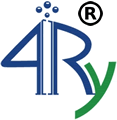4Ry’s Technologies & Applications
ChIPS Solves Livestock Spraying Problems

Livestock must be treated for flies, fleas, ticks, mites, lice, mosquitos, and other external parasites. They can either be dipped in a parasiticide plunge bath or sprayed.
There are three main ways of spraying livestock: spray races, mechanized power spraying, and hand spraying. A spray race looks like a scaled-down car wash. Cattle or sheep walk through it and are sprayed by nozzles from all angles.
Power spraying uses motorized sprayers to spray livestock, either individually or in groups. Hand spraying is done by workers using backpack containers of parasiticides. Spray races are the most expensive option, but the most thorough. Hand spraying is the cheapest, but least thorough. Power spraying falls in the middle on both measures.
Precise, Targeted Livestock Spraying
Whatever spraying method is used, 4Ry’s Charge Injected Precision Spraying (ChIPS) technology substantially lowers the cost and improves efficiency. ChIPS uses 4Ry’s patented Spray Triode Atomizer, a nozzle that charges the parasiticide so that each droplet is negatively charged when it leaves the nozzle.
Because the droplets are identically charged they repel each other, a force known as Coulomb repulsion (after the scientist who identified and described it over 200 years ago). Coulomb repulsion governs the flight of the droplets and creates a precise, targeted spray.
No Water, Propellants, or Fillers
The parasiticides used in livestock spraying consist of the active ingredient substantially diluted in water, plus propellants and fillers to enhance the spray. Incorporating Coulomb repulsion, 4Ry’s Spray Triode Atomizer eliminates the need for costly water, propellants, and fillers. Only the active ingredient or basic formulation is required. Eliminating water can be especially important in locations where it is in short supply.
The Spray Reaches Where Conventional Livestock Spraying Can’t
Once they’ve left the nozzle, the individually charged particles seek a ground: the livestock being sprayed. The spray thoroughly coats the entire animal, including areas and cavities on its body that current spraying methods miss.
Almost all droplets hit the animal; there is virtually no aerosol drift. This significantly reduces the risk of inhaling parasiticides for both spray operators and livestock. It also virtually eliminates soil and groundwater contamination in the surrounding environment.
A Better Way to Spray Livestock
4Ry’s ChIPS technology more thoroughly sprays and coats livestock at lower cost and higher efficiency—and with far less environmental and health risks—than current methods.
